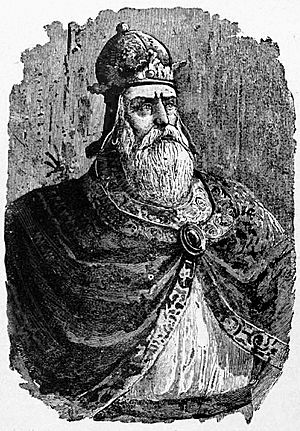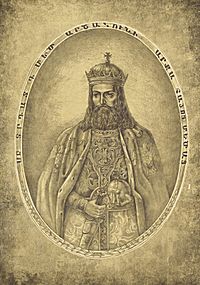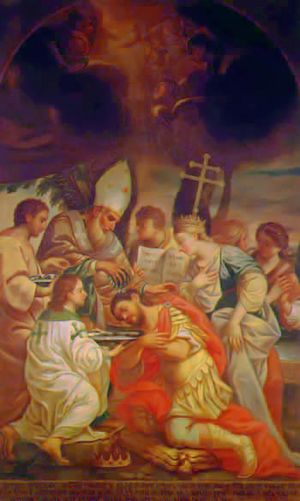Tiridates III of Armenia facts for kids
Quick facts for kids Tiridates III the Great |
|
|---|---|
 |
|
| King of Armenia | |
| Reign | 298–c. 330 AD |
| Predecessor | Khosrov II |
| Successor | Khosrov III the Small |
| Born | 250s AD |
| Died | c. 330 AD |
| Burial | Kemah |
| Consort | Ashkhen |
| Issue | Khosrov III the Small Salome of Armenia |
| Dynasty | Arsacid dynasty |
| Father | Khosrov II of Armenia |
| Religion | Zoroastrianism (before 301) Armenian Christianity (after 301) |
Tiridates III (born around 250 AD, died about 330 AD) was a powerful king of Armenia. He is also known as Tiridates the Great. He ruled the Armenian kingdom from about 298 AD to 330 AD.
In 301 AD, Tiridates made a very important decision. He declared Christianity to be the official religion of Armenia. This made Armenia the very first country in the world to officially become Christian.
Contents
Understanding the Name Tiridates
The name "Tiridates" comes from Ancient Greece. It is a Greek version of the Parthian name Trdat. This name means "created by Tir."
Tir is an important spiritual being in the ancient Zoroastrian religion. The name Tiridates also appeared in other languages. For example, in Latin, it was also "Tiridates."
Tiridates's Early Life
Tiridates III was the son of Khosrov II of Armenia, who was also a king. Sadly, his father was killed in 252 AD. An enemy agent named Anak assassinated him.
Tiridates had a sister named Khosrovidukht. He was named after his grandfather, Tiridates II of Armenia. Anak, the killer, was caught and executed.
His son, Gregory the Illuminator, was taken to a safe place. Because Tiridates was the only child left to be king, he was sent to Rome. He was just a baby at the time.
In Rome, Tiridates received a good education. He learned many languages and became skilled in military strategies. He also understood Roman law very well. An Armenian historian, Movses Khorenatsi, described him. He said Tiridates was a strong and brave fighter. He often led his army to victory in battles.
Becoming King of Armenia
In 270 AD, the Roman emperor Aurelian fought against the Sassanids. The Sassanids had taken over from the Parthians. Aurelian pushed them back from the eastern borders.
Tiridates was the rightful heir to the Armenian throne. Armenia was then under Persian control. In 298 AD, Tiridates returned to Armenia. He quickly gathered an army and drove the enemies out.
When Tiridates became king, he made Vagharshapat his capital city. This city had also been the capital for his father. For a while, things went well for Tiridates. He not only removed his enemies but also fought in Assyria.
At that time, the Persian Empire was having problems. Two brothers, Hormuz and Narses, were fighting for the throne. Narses eventually became the King of Persia. Narses then focused his army on Tiridates.
The fight became too difficult for Tiridates. He again sought help from the Romans. The friendship between Rome and Armenia grew stronger. This was especially true when Diocletian was the Roman emperor. Tiridates had grown up in Rome. Also, the Persians kept attacking, and his father had been killed. All these reasons made the alliance strong.
With Diocletian's help, Tiridates pushed the Persians out of Armenia. In 299 AD, Diocletian made Armenia a mostly independent state. It was like a protected country. This was probably to use Armenia as a shield against Persian attacks.
In 297 AD, Tiridates married a princess named Ashkhen. She was from the Alani people. They had three children together. Their son was named Khosrov III. They also had two daughters, one named Salome. The other daughter married St. Husik I. He was an early leader of the Armenian Apostolic Church.
Armenia Becomes Christian
| Saint Tiridates III the Great Սբ. Տրդատ Մեծ թագավոր |
|
|---|---|

Tiridates III the Great, the Great King of the Armenians.
|
|
| King of Armenia | |
| Resting place | Kemah, Erzincan, Armenia |
| Venerated in | Oriental Orthodoxy Catholic Church |
| Feast | Saturday before fifth Sunday after Pentecost (Armenian Apostolic Church) |
| Attributes | Crown Sword Cross Globus cruciger |
| Patronage | Armenia |
The story of how King Tiridates and Armenia became Christian is very famous. It comes from a book written in the 400s AD. The book is called "The History of the Armenians" by Agathangelos.
The story tells about Gregory the Illuminator. He was the son of Anak, the man who killed Tiridates's father. Gregory was raised as a Christian. He felt bad about his father's actions. So, he joined the Armenian army and became the king's secretary.
By the end of the 200s AD, Christianity was growing in Armenia. However, most people still followed Zoroastrianism. King Tiridates also worshiped many ancient gods.
One day, during a Zoroastrian ceremony, Tiridates told Gregory to place flowers. He wanted Gregory to put them at the feet of a statue of the goddess Anahit. Gregory refused, saying he was a Christian. This made the king very angry.
The king became even angrier when he learned Gregory was Anak's son. Anak was the traitor who killed Tiridates's father. Gregory was tortured and then thrown into Khor Virap. This was a very deep underground prison.
While Gregory was in prison, a group of Christian nuns came to Armenia. They were led by Gayane. They were running away from Roman persecution. Tiridates heard about them. He also heard about the great beauty of one nun, Rhipsime.
He brought them to his palace and wanted to marry Rhipsime. She refused him. The king then had the entire group of nuns tortured and killed. After this terrible event, Tiridates became very ill. Legend says he started acting like a wild boar. He wandered aimlessly in the forest.
Khosrovidukht, Tiridates's sister, had a dream. In her dream, Gregory was still alive in the dungeon. She dreamed he was the only one who could cure the king. It had been 13 years since Gregory was imprisoned. It seemed unlikely he would still be alive.
But they found him, and he was indeed alive. A kind woman had kept him alive. She threw a loaf of bread down into Khor Virap every day.
Tiridates was brought to Gregory. In 301 AD, Gregory miraculously cured the king. Seeing this amazing power, the king immediately declared Christianity the official state religion. This made Armenia the first country to officially adopt Christianity. Tiridates then appointed Gregory as the leader of the Armenian Apostolic Church.
Becoming Christian was a huge and important moment for Armenia. It seems that the Armenian kings becoming Christian was partly a way to stand against the Sassanids.
Later Years of Tiridates's Reign
Changing from the old Zoroastrian religion to Christianity was not easy. Tiridates often used force to make people accept the new faith. Many armed conflicts happened because Zoroastrianism was very important to Armenians.
There was even a battle between the king's army and the Zoroastrian followers. This battle weakened the power of those who believed in many gods. Tiridates spent the rest of his life trying to remove all ancient beliefs. He destroyed many statues, temples, and old writings. Because of this, we know little about ancient Armenian history from local sources.
The king worked hard to spread Christianity. He died in 330 AD. The historian Movses Khorenatsi wrote that some noble families planned against Tiridates. They eventually poisoned him.
Tiridates III, his wife Ashkhen, and his sister Khosrovidukht are considered Saints. They are honored in the Armenian Apostolic Church. Their special day is celebrated on the Saturday after the fifth Sunday after Pentecost.
Tiridates's Burial Place
Tiridates is believed to be buried south of Mount Sebuh. This area is now called Kara Dağ. His burial site is in a ruined fortress named Drdadpert. It is also known locally as Durnakale. This fortress is in the Kemah district of the Erzincan province.
The fortress is close to the Saint Gregory the Illuminator Monastery. It is also near the Grotto of Saint Mane.
Gallery
-
Gregory the Illuminator baptizes Tiridates III.
See also
 In Spanish: Tiridates III de Armenia para niños
In Spanish: Tiridates III de Armenia para niños
- Armenian Apostolic Church
- Arsacid dynasty of Armenia
- Saint Gregory the Illuminator Cathedral, Yerevan





